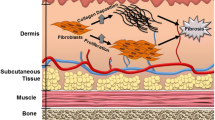Abstract
The first derivatives of gelatin and type I collagen fluorescence spectra were characterized in order to describe the effect of free radicals on pyridinoline (PYD) cross-links. The different gas saturation conditions were used to investigate the effect of different free radicals. An analysis of first derivative fluorescence spectra suggests that PYD cross-link fluorescence emission is composed of three peaks in gelatin, but only two in type I collagen. The PYD cross-link was photo-degraded more than other gases in the presence of O2. This suggests that the singlet oxygen (1O2) plays a key role when using photodynamic therapy to treat skin fibrosis disease with Hypocrellin B (HB).
Access this chapter
Tax calculation will be finalised at checkout
Purchases are for personal use only
Similar content being viewed by others
References
Agostinis P, Berg K, Cengel KA et al (2011) Photodynamic therapy of cancer: an update. CA Cancer J Clin 61(4):250–281
Wang K, Gu Y, Liu FG et al (2002) Several questions of Photodynamic Therapy treatment the Port wine stains in clinic (in Chinese). Chin J Laser Med Surg 11:190–192
Webber J, Herman M, Kessel D et al (2000) Photodynamic treatment of neoplastic lesions of the gastrointestinal tract. Langenbecks Arch Surg 385:299–304
Qumseya BJ, David W, Wolfsen HC (2013) Photodynamic therapy for Barrett’s esophagus and esophageal carcinoma. Clin Endosc 46:30–37
Singh RP, Sharad S, Kapur S (2004) Free radicals and oxidative stress in neurodegenerative diseases: relevance of dietary antioxidants. Indian Acad Clin Med 5(3):218–225
Zhang JC, Liu W, Yi ZZ et al (2009) The molecular mechanism of photodynamic therapy to fibrosis: regulation on the pyridinoline cross-link formation in collagen. Chin Sci Bull 54:2230–2234
Huang NY, Liu FG, Gu Y (2007) Animal experiment of the port wine stains’ treatment by photodynamic therapy with two dosage form of hypocrellin B (in Chinese). Acta Laser Biol Sin 16:359–363
Smith RP (2002) Photodynamic therapy. Curr Probl Cancer 26(2):61–108
Dennis AH, David RE (1996) Molecular site specificity of pyridinoline and pyrrole cross-links in type I collagen of human bone. J Biol Chem 271:26508–26516
Trojanowska M, LeRoy EC, Krieg BET (1998) Pathogenesis of fibrosis: Type I collagen and the skin. J Mol Med 76:266–274
van der Slot AJ, Zuurmond AM, van den Bogaerdt AJ et al (2004) Increased formation of pyridinoline cross-links due to higher telopeptide lysyl hydroxylase levels is a general fibrotic phenomenon. Matrix Biol 23:251–257
van der Slot-Verhoeven AJ, van Dura EA, Attema J et al (2005) The type of collagen cross-link determines the reversibility of experimental skin fibrosis. Biochim Biophys Acta 1740:60–67
Green GL, O’Haver TC (1974) Derivative luminescence spectrometry. Anal Chem 46(14):2191–2196
Mozo-Villarías A (2002) Second derivative fluorescence spectroscopy of tryptophan in proteins. J Biochem Biophys Methods 50:163–178
Zhao BZ, He YY (2010) Recent advances in the prevention and treatment of skin cancer using photodynamic therapy. Expert Rev Anticancer Ther 10(11):1797–1809
Barreto JC, Smith GS, Strobel NHP et al (1995) Terephthalic acid: a dosimeter for the detection of hydroxyl radicals in vitro. Life Sci 56(4):89–96
Acknowledgments
This work was financially supported by the National Nature Science Foundation of China (21362010), and the Yunnan Natural Science Foundation (2010ZC0153).
Author information
Authors and Affiliations
Corresponding author
Editor information
Editors and Affiliations
Rights and permissions
Copyright information
© 2016 Springer International Publishing Switzerland
About this paper
Cite this paper
Yan, H., Chen, Y., Zhang, J., Liu, W., Chen, R. (2016). The Role of Free Radicals in the Photodynamic Treatment of Fibrotic Skin Diseases. In: Luo, Q., Li, L., Harrison, D., Shi, H., Bruley, D. (eds) Oxygen Transport to Tissue XXXVIII. Advances in Experimental Medicine and Biology, vol 923. Springer, Cham. https://doi.org/10.1007/978-3-319-38810-6_10
Download citation
DOI: https://doi.org/10.1007/978-3-319-38810-6_10
Published:
Publisher Name: Springer, Cham
Print ISBN: 978-3-319-38808-3
Online ISBN: 978-3-319-38810-6
eBook Packages: Biomedical and Life SciencesBiomedical and Life Sciences (R0)




